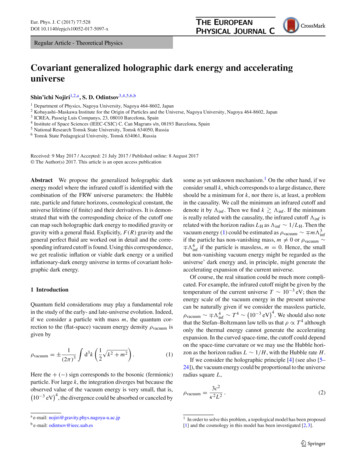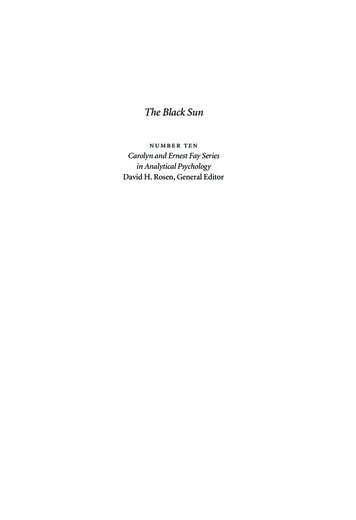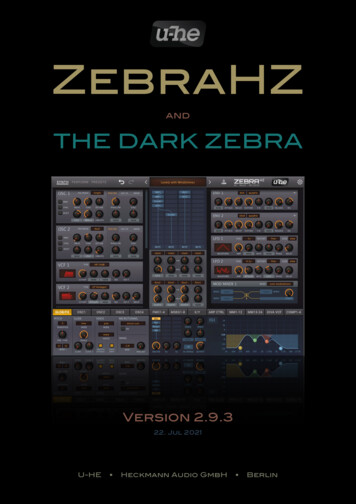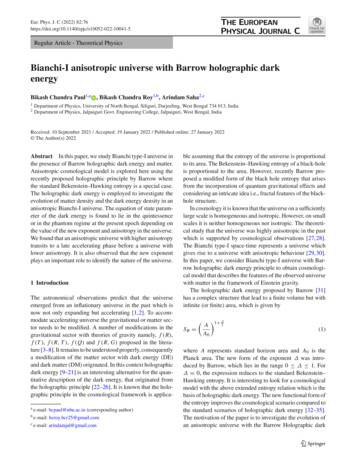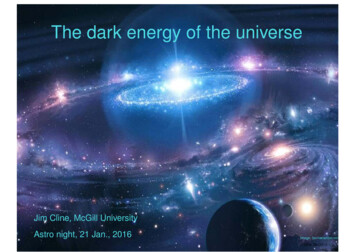
Transcription
The dark energy of the universeThe dark energy of the universeJim Cline, McGill UniversityAstro night, 21 Jan., 2016image: bornscientist.comJ.Cline, McGill U. – p. 1
Dark Energy in a nutshellIn 1998, astronomers presented evidence that the primaryenergy density of the universe is not from particles orradiation, but of empty space—the vacuum.Einstein had predicted it 80 years earlier, but few peoplebelieved this prediction, not even Einstein himself.Many scientists were surprised, and the discovery wasconsidered revolutionary.Since then, thousands of papers have been written on thesubject, many speculating on the detailed properties of thedark energy.The fundamental origin of dark energy is the subject ofintense controversy and debate amongst theorists.J.Cline, McGill U. – p. 2
Outline History of the dark energy Theory of cosmological expansion The observational evidence for dark energy What could it be? Upcoming observations The theoretical crisis !!!J.Cline, McGill U. – p. 3
Albert Einstein invents dark energy, 1917Two years after introducing generalrelativity (1915), Einstein looks forcosmological solutions of his equations.No static solution exists, contrary toobserved universe at that timeHe adds new term to his equations to allowfor static universe, the cosmologicalconstant λ:J.Cline, McGill U. – p. 4
Einstein’s static universeThis universe is a three-sphere with radius R and uniform mass density ofstars ρ (mass per volume).potential energymechanical analogyRRBy demanding special relationships between λ, ρ and R,λ κρ/2 1/R2 , a static solution can be found. (κ Newton’s gravitationalconstant, κ 8πG, appearing in force law F Gm1 m2 /r2 )Einstein did not then know that any small perturbation of R away from thisvalue would cause the universe to collapse (R 0) or expand forever(R ), like a ball balanced on the top of a hill.J.Cline, McGill U. – p. 5
Why Einstein needed λIf λ 0, there is no point of equilibrium,potential energywithout λRThe spherical universe may expand for a while, but it reachesmaximum size and then starts to collapse, as shown byAlexander Friedmann in 1922 (at first rejected by Einstein, later he agreed)Einstein’s theory with λ 0 predicts a dynamical universe!J.Cline, McGill U. – p. 6
What is meant by dark energy?“Dark energy” is the new terminology for the cosmologicalconstant. λ/κ is the energy per volume of empty space!Einstein’s equations of general relativity (modern notation,λ Λ): Gµν Λ gµν κ T µνcurvature c.c. mass/energy densityJ.Cline, McGill U. – p. 7
What is meant by dark energy?“Dark energy” is the new terminology for the cosmologicalconstant. λ/κ is the energy per volume of empty space!Einstein’s equations of general relativity (modern notation,λ Λ): Gµν Λ gµν κ T µνcurvature c.c. mass/energy densityNothing prevents us from moving Λ from one side of theequation to the otherJ.Cline, McGill U. – p. 8
What is meant by dark energy?“Dark energy” is the new terminology for the cosmologicalconstant. λ/κ is the energy per volume of empty space!Einstein’s equations of general relativity (modern notation,λ Λ): Gµνcurvature κ T µν Λ g µν mass/energy density c.c.By putting c.c. on right side of equation, it looks like a newcontribution to the energy density of universe.But it has nothing to do with stars or other kinds of knownmatter. It is energy of the vacuum.J.Cline, McGill U. – p. 9
Size of the dark energy densityTo get his static universe, Einstein had to assume that Λbalances the effect of the universe’s normal matter density, sothat energy density of the vacuum is half of that in matter(stars)ρmρΛ 2Using modern value of ρm , this givesρΛ 10 30 g/cm3Using Einstein’s famous relation E mc2 , we can convertbetween mass and energy.If Leacock has volume (10 m)3 , it contains 10 9 J ofvacuum energy. The lighting consumes 1000 J/s.J.Cline, McGill U. – p. 10
Expansion of the universe?1912-1924, American astronomer Vesto Slipher found thefirst evidence for expansion of the universe through theredshifts of galaxies (then called nebulae).Spectral lines (light of a pure color) from atomic transitionswere redshifted by the motion of the galaxies away from us.Most galaxies were seen to be moving away, not toward us.Expansion of the universe? Not all were convinced.(E.g., Fritz Zwicky, “tired light” theory)J.Cline, McGill U. – p. 11
Expansion and redshiftImagine universe as surface of expanding balloon. (Radialdirection has no physical significance!)timeStationary observers move away from each other.Light sent from one to the other gets stretched: redshifted.Amount of redshift is exactly proportional to expansionJ.Cline, McGill U. – p. 12
Measuring the redshift (z)Spectral lines (from splitting light into colors using prism orgrating) are like a fingerprint of a star or supernovaλ0R0 1 zλRwhere λ0 and R0 denotetoday’s (larger) values,and λ, R refer to timewhen light was emitted.At z 1, universe washalf of its present sizeImage: nding-universe-red-shift.html/Even if the spacing between lines is stretched, the pattern isthe same so we can recognize which lines are which.J.Cline, McGill U. – p. 13
de Sitter’s expanding universeUsing Einstein’s equations, in 1917 (soonafter Einstein’s static universe paper) Dutchastronomer Willem de Sitter found anexpanding universe with no matter, only Λ.German mathematician / physicist /philosopher Hermann Weyl noted that lightwould be redshifted in such a universe(1923).Link between universe expansion and redshift is planted intheorists minds.Einstein writes to Weyl (1923), "If there is no quasi-staticworld, then away with the cosmological term”Einstein had been reluctant to introduce Λ in the first place;he was only forced to by the perception of a static universe.J.Cline, McGill U. – p. 14
Hubble’s expansionIn 1929, American astronomer (and former college basketballchampion) Edwin Hubble publishes more evidence forexpansion of the universe.http://apod.nasa.gov/diamond jubilee/d 1996/hub 1929.htmlHe showed that distant galaxies move away from us withspeed proportional to their distance. (actually redshift d)This is exactly what the expanding universe picture predicts!J.Cline, McGill U. – p. 15
Hubble’s lawθ1Rθ2dθ1θ1θ2Rθ2RtimeThe distance between two observers is proportional to theangle (which is constant),d R(t) θThe speed at which they move away from each other has thesame proportionality,d Ṙ θThereforeṘ d d HdR(H Hubble “constant”)Speed of recession is proportional to distanceJ.Cline, McGill U. – p. 16
The Hubble parameterH is the slope of the velocity-distance relationship, d H d(Using redshifts determined bySlipher without giving credit!)kmModern value: H 67.3 s·Mpc(1 Mpc 3.3 106 light - years)Most distant galaxy is 4000 Mpc away. Hubble’s law says it isreceding from us with velocity 67.3 4000 267, 000 km/s,0.9 times the speed of light!J.Cline, McGill U. – p. 17
Hubble’s prophecyHubble ends his famous paper with a prophetic remark:.The foreseen departure from linearity is exactly howmodern astronomers discovered the dark energy!J.Cline, McGill U. – p. 18
Lemaître’s expansion1927, Georges Lemaître, Belgian astronomer,physicist, priest, decorated WWI veteran, andlater originator of the big bang concept, reachedthe same conclusions as Hubble in a paperpublished two years earlier!It was written in French and published in a Belgian journal,so did not attract immediate attention. But his famousmentor Arthur Eddington promoted it.Lemaître used similar data as Hubble, derived the “HubbleLaw” and estimated the “Hubble constant,” getting a similarvalue to Hubble.A translation of his paper into English was published in 1931,with the derivation of the Hubble constant omitted!The influence of Hubble may be suspected in this censorship.J.Cline, McGill U. – p. 19
Lemaître versus HubbleD. Block (2011) shows comparison of data used by Lemaître and e did not construct the left-hand plot, but these were the data heused. Hubble’s data were corrected for peculiar motions of the galaxiesand so look more linear.He also gave a full theoretical explanation of “Hubble’s law,” completelylacking in Hubble’s paper!J.Cline, McGill U. – p. 20
Lemaître censoredBlock also showed which parts of Lemaître’s article were not translatedinto English. R′ /R is the “Hubble constant”.J.Cline, McGill U. – p. 21
Einstein repudiates ΛWith the expanding universe, there seemed to be no needfor Λ. Einstein concludes it is simpler to omit it from hisequations.Russian theorist GeorgeGamow writes in 1956Scientific American articlethat Einstein called Λ his“greatest blunder”Historians of science find no corroborating evidence thatEinstein thought it was such a big mistake.We will see that in fact he was right to include Λ after all!Rather than a fundamental change to his original equation, it can be seen as just a newcontribution to the energy density, coming from the vacuumJ.Cline, McGill U. – p. 22
Effect of Λ on expansion historyEinstein’s equations predict that the value of Λ can affect the expansion ofthe universe as a function of time, R(t),Λ 0Λ 0Λ 0R(t)t (time)At early times after the big bang, matter and radiation was very dense, soρ ρΛ ,p pΛand the effect of Λ is negligible. But ρ decreases with time as 1/R3 or1/R4 , while ρΛ remains constant, and comes to dominate the expansion.J.Cline, McGill U. – p. 23
Effect of Λ on expansion historySimilarly, Λ affects the Hubble rate,H(t) RRΛ 0Λ 0Λ 0t (time)Recall that Hubble deduced H by measuring the redshift of galaxies as afunction of their distance. But how to measure H as a function of time?The light from a distant galaxy takes time to reach us, t d/cWe see it not as it is today, but how it looked in the past, including itsrecession speed at the earlier time, t in the past!J.Cline, McGill U. – p. 24
How to measure ΛInstead of Hubble’s simple linear law for recession velocityversus distance,v Hdwe realize that it depends upon the time at which the lightwas emitted from the galaxy,v(t) H(t)dwhere t d/c. Thus v versus d is no longer a straight line buta curve with changing slope H(d/c).This is what Hubble meant when he said.Its precise shape is sensitive to Λ.J.Cline, McGill U. – p. 25
The challenge of measuring distanceVelocity (redshift) is easy to measure, but how can we knowhow far away the galaxy is? This is the difficult part.Note brightness(distance) versusredshift (recessionvelocity) is plottedrather thanvelocity versusdistanceS. Perlmutter et ne, McGill U. – p. 26
Brightness versus distanceA distant light looks dimmer than a nearby one. Brightness (luminosity)falls with square of distance: L 1/r 2Image: http://www.shutterstock.comIf we knew the intrinsic brightness of the light (e.g., 100 W lightbulb) wecould calculate the distance from the measured brightnessJ.Cline, McGill U. – p. 27
“Standard candles”But we do not know the intrinsic brightness of distant galaxies.We need to identify some object in the galaxies whoseintrinsic brightness is known, a so-called “standard candle”Lemaître and Hubble used a kind of variablestar whose brightness varies periodicallywith time, known as “Cepheids”It is possible to directly measure thedistances to the most nearby Cepheids.From this it was shown that their intrinsicbrightness is proportional to their frequencyof variation.Images: http://cseligman.com/text/stars/variables.htm cepheid.htmlJ.Cline, McGill U. – p. 28
A more powerful candleTo go to greater distances, needed to find the small deviationsfrom linearity in the Hubble plot, Cepheids are too dim to see.A more powerful standard candle is requiredSupernovae, stars exploding at the end of their life, are by farthe brightest objects in the universe.For a brief time, they outshine their entiregalaxy!Unfortunately their intrinsic brightness is notat all es/99legacy/11-11-1999.htmlBut in 1993 it was proven by American astronomer M. Phillipsthat a certain type (called Ia) of supernovae can bestandardizedJ.Cline, McGill U. – p. 29
Type Ia supernova light curvesType Ia supernovae withlarger intrinsic brightness(“absolute magnitude”) shinelonger than dimmer ones.It was discovered thatbrightness versus time canbe described by a singleuniversal function by doingsimple rescaling.By measuring shape of lightcurve, the absolutebrightness can be deduced.Type 1a SNe become thenew standard candle.Note the scatter: they are notperfect. Need to observe many SNeto get a significant measurement.Image: g-the-candle/J.Cline, McGill U. – p. 30
(Most distant type Ia supernova)In 2013, Hubble SpaceTelescope found the mostdistant type Ia SN to date,1010 light-years away,1000 times farther thanHubble’s sample, atredshift z istant-type-ia-supernova-observed/J.Cline, McGill U. – p. 31
The discovery of dark energyIn 1998 two competing collaborations (High-Z and SCP)published the first evidence for nonvanishing ΛThey got compatible results consistent with a spatially flatuniverse with 30% of energy density in matter and 70% in Λ.J.Cline, McGill U. – p. 32
The experimental challengesAs described by SCP team member G. Goldhaber, the pathto eventual success was not easy,http://arxiv.org/abs/0907.3526Supernova is easiest to discover when it is brightest,but by then it is too late to measure early part of lightcurve.Accurate distance determination requires both parts ofthe light curveJ.Cline, McGill U. – p. 33
Supernovae on demandSCP leader Saul Perlmutter developed an automated way to discovermany supernova much faster. Many patches of sky were photographedand compared by computer at intervals of one month.http://www.ia.ucsb.edu/pa/image.aspx?pkey 2550&Position 1J.Cline, McGill U. – p. 34
Perlmutter describes the process in this diagram:http://www.nobelprize.org/nobel dfhttp://arxiv.org/abs/0907.3526J.Cline, McGill U. – p. 35
The Hubble plotsBased on 16 (High-Z) and 42 (SCP) distant supernovaeSupernovaCosmologyProjectHigh 1http://arxiv.org/abs/astro-ph/9812133Data is shown along with theoretically predicted curves,assuming different values ofΩM :ΩΛ :fraction of energy density in matterfraction of energy density in ΛJ.Cline, McGill U. – p. 36
Λ versus matter densityHigh ZSCPΩΜNote degeneracy (a linear combination of ΩΛ and ΩM is determined)But regardless, ΩΛ 0 is inconsistent unless ΩM 0 also!J.Cline, McGill U. – p. 37
Other measurements remove ev-dark-energy.pdfToday we have more thanjust the supernovameasurements to pindown the value of ΩΛ .Cosmic microwavebackground (CMB) andbaryon acousticoscillations (BAO)depend differently uponthe parameters, allowinga completedetermination.Current values: Ωm 0.315 0.017, ΩΛ 0.685 0.017.Cosmology has become (more of) a precision science!J.Cline, McGill U. – p. 38
The 2011 Nobel Prize in PhysicsAfter an unusually short interval following discovery, theNobel prize in physics was awarded to leaders of both s-accelerating-universe-dark-energy.htmlJ.Cline, McGill U. – p. 39
The theoretical conundrumFollowing Zeldovich, theorists had become concerned aboutwhy Λ was not extraordinarily larger than observed.Estimates based on quantum theory were 10120 times toolarge!This was considered by many to be the most seriousconceptual problem in theoretical 03/RevModPhys.61.1J.Cline, McGill U. – p. 40
The quantum vacuumtimeFrom the quantum mechanical viewpoint, the vacuum is notjust empty space. It can be thought of as being filled withvirtual particle/antiparticle pairs that appear and disappear atrandom.particleantiparticlespaceJ.Cline, McGill U. – p. 41
Energy of the quantum vacuumAn estimate gives the vacuum energy densityMpρΛ 3 10100 g/m3LPMp is the “Planck mass” derived from Newton’s gravitational constant, Mp 1/ G 10 5 gLp is the “Planck length,” also derived from Newton’s constant, Lp G 10 35 m (in particle physics units c 1).The measured value isρΛ 10 23 g/m3Off by 123 orders of magnitude. The worst prediction in thehistory of science!J.Cline, McGill U. – p. 42
How to explain such a small Λ?Before 1998, a popular idea was that for some as yetunknown reason, Λ 0 exactly.Zero sounds much simpler to explain than 10 123 , comparedto the natural value.For example it was known that particles with spin 1/2(fermions) contribute negatively to Λ, while those with spin 0or 1 (bosons) contribute positively.But the 1998 measurement of Λ 6 0 disproved this elegantpossibility.Many theorists have tried, but no convincing mechanism toproduce such a small value has been proposed.(With perhaps one exception)J.Cline, McGill U. – p. 43
Perhaps dark energy is not constant?Many theorists have studied models where dark energy is notconstant but can vary with time: “quintessence”energy density ρ QρQ can be pictured as the height of aball rolling down a shallow hill.These theories don’t explain why thehill goes down to “sea level” insteadof nonzero elevation — why is thereno Λ in addition to ρQ ?quintessence field, QPressure is no longer simply ρ, insteadpQ wρQ , 1 w 1/3Acceleration is reduced, relative to constant Λ with w 1.w is called “equation of state” parameterJ.Cline, McGill U. – p. 44
No evidence for time variationCurrent observations constrain w only very weakly.Current measurements indicatew 1.10 0.09Consistent with constant Λ, w 1w 1 is theoretically disfavored(“phantom” dark energy)Phantom dark energy isincompatible with quantummechanics, but many theoristscontinue to consider it -rev-dark-energy.pdfJ.Cline, McGill U. – p. 45
The Dark Energy SurveyInternational collaboration withtelescope in Chile since 2013Plans to discover 3000 distantsupernovae and observe300,000,000 galaxiesBut will they significantly improvedetermination of ss releases/2013/DES-2013-images.htmlJ.Cline, McGill U. – p. 46
The Large Synoptic Survey TelescopeAnother international collaboration,building telescope in Chile for 2019Also observing billions of galaxiesBut will they significantly improvedetermination of , McGill U. – p. 47
Present and forecasted constraints on wShowing wa (rate of change of w ) versus w :current constraintDES projectedLSST projectedEven after measuring 1000s of supernovae and billions ofgalaxies, w will not be determined to much better than /1211.0310v1.pdfJ.Cline, McGill U. – p. 48
Modified gravityAnother popular approach is to modify Einstein’s equations to getacceleration without Λ (in the hope that for some reason Λ 0), orto explain why even very large Λ does not give acceleration.modified gravityEinstein gravityThese theories tend to bevery complicated, and tocreate more problems thanthey solve (e.g., makingwrong predictions forproperties of gravity asmeasured in the solarsystem).The cosmological constant is by far the simplest explanation ofcosmic acceleration.But why is it so small?J.Cline, McGill U. – p. 49
The anthropic explanationIn 1987, S. Weinberg noted that if Λ was too large, we could not behere to measure it. The universe would expand too fast for galaxiesand stars to form if ρΛ 500 ρm RevLett.59.2607Suppose there were many universes with different values of Λ; thenwe would only consider those that are compatible with life. (Stringtheory and cosmic inflation provide such a framework.)This vastly reduces the severity of the cosmological constantproblem. Now the observed ρΛ is only 100 times smaller than itsmaximum expected value, rather than 10120 . Events with probability1/100 happen to us all the time.Many scientists view this as just giving up on a real explanation. Mypersonal view is that it is the most likely explanation that has beenproposed so far.J.Cline, McGill U. – p. 50
The multiverseenergy densityA candidate theory for unifying gravity with the other forces of nature,string theory, is thought to predict a huge range of possible values for thedark energy, depending on where we happen to settle in the energylandscape.caesmsorlaldfieDifferent regions in the universe settle into separate minima with differentvalues of Λ. In this context, anthropic principle makes /10/13/landscape-multiverseJ.Cline, McGill U. – p. 51
Eternal inflationWhile the scalar field rolls down the hill, it has a large vacuum energy andgives accelerated expansion in the early universe. This framework ofcosmological “inflation” at the time of the big bang has wide theoreticaland experimental validation.Many theorists believe that inflationcontinues forever in distant parts of theuniverse, continually spawning newsubuniverses falling into different minimaof the landscape.This gives a mechanism for populatingthe different minima.A.D. Linde, 9/1987/T15/024/pdfJ.Cline, McGill U. – p. 52
Is dark energy mysterious?Many scientists preface talks about dark energy by saying “it is acomplete mystery, . . . we have no idea what it is.”I have argued that we have a very good idea: it is vacuum energyfrom quantum fluctuations, giving rise to Einstein’s cosmologicalconstant Λ. (Understanding its size is another matter.)de Sitter seems to have anticipated thisdiscussion in a popular article (1930):“What, however, blows up the ball? What makesthe universe expand or swell up? That is done byΛ. No other answer can be given. . . . To some itmay sound unsatisfactory that we are not able topoint out the mechanism by which Λ contrives todo it. But there it is, we cannot go beyond themathematical equations and . . . the behavior of Λis not more strange or mysterious than that of thegravitational constant κ, to say nothing of thequantum constant h, or the velocity of light c.”http://arxiv.org/abs/1111.4623J.Cline, McGill U. – p. 53
ConclusionsThe concept of dark energy continues to intrigue andconfound many physicists.Einstein invented it but could never accept it, and sometoday still can’t.Why it is so small compared to theoretical expectationspersists as an outstanding problem.Big experimental resources are aimed at measuring itsproperties better, but they may only prove with slightlybetter accuracy that it is constant Λ rather than somethingmore exotic.J.Cline, McGill U. – p. 54
Extra slidesJ.Cline, McGill U. – p. 55
Theoretical developmentsOnce the idea of Λ was introduced, theorists did not easily forget it, butwithout further experimental evidence, nothing definitive could be said.Already in 1911, German physicist Walther Nernst showed thatthe new quantum theory predicts vacuum should have energy.The idea did not attract much notice at the time.Late 1920s, German physicist Wolfgang Pauli tries to computeΛ and finds it is so big that universe would “not even reach tothe moon.” (Recall Λ 1/R2 .) Dismisses vacuum energy.1928, Einstein argues against quantum mechanical origin ofvacuum energy, saying it should be zero, independently of Λterm in his gravitational equation.1948, Dutch physicist Hendrik Casimir correctly predictsvacuum energy between conducting (metal) plates shouldcause them to attract each other. Nobody connects this to Λ.1967-68, Russian physicist Yakov Zeldovich estimates Λ inquantum theory (like Pauli did) and finds it is too large. Otherphysicists start to pay attention.J.Cline, McGill U. – p. 56
Observational Hints of ΛWhy did some theorists start to pay more attention to Λ inthe 1960’s? A few astronomers were starting to think that Λmight be nonzero. This gave theorists more motivation totake it seriously.The observed rate of expansion of the universe seemed notto match expectations from Einstein’s theory with Λ 0;having Λ 6 0 could improve the agreement.To understand why, we need to look at the equations thatdetermine how fast the universe expands.These were deduced from Einstein’s equations byAlexander Friedmann in 1922. They depend upon themass/energy density and the curvature of the universe.J.Cline, McGill U. – p. 57
Expansion and curvature of the universeOur 3D universe is similar to the 2D surface of a sphere. Thedistance between two ants (galaxies) grows like the “scalefactor” R that is like the radius of the sphere (positivecurvature).dRRRtimeAs R increases, the volume of space increases with it.A similar picture could be drawn for a flat universe (zerocurvature)RRRtime(Imagine membrane being stretched.)J.Cline, McGill U. – p. 58
Expansion and curvature of the universeBesides positive and zero curvature, it is possible for space tobe negatively curved,positivenegativezeroEinstein assumed positive curvature in his static universesolution. In this case, total volume and mass of universe isfinite.If zero or negative curvature, universe is infinite.J.Cline, McGill U. – p. 59
The Friedmann equationsThey are equivalent to Einstein’s equations for the simplifiedmodel of a universe that is homogeneous and isotropic.1st Friedmann equation determines relative rate of expansion(Hubble rate):!2κṘΛk2 ρ 2H R33Rwhere k ( 1 or 0) is sign of curvature,ρ is mass/energy density of matter and radiation.We can also write it asH2kκ (ρ ρΛ ) 23RPositive energy density drives the expansion of the universe,while positive curvature tends to slow it down.J.Cline, McGill U. – p. 60
The Friedmann equations2nd Friedmann equation determines acceleration of theuniverse’s expansion:κΛR̈ (ρ 3p) R63where p is the pressure due to radiation. Einstein’s staticsolution assumed p 0. To get static universe, he needed tobalance ρ against Λ.We can also write it in the formR̈κ (ρ ρΛ 3p 3pΛ )R6Dark energy has the curious property that pΛ ρΛ :if ρΛ 0, its pressure is negative (suction)!And this causes positive acceleration!J.Cline, McGill U. – p. 61
Negative pressure and accelerationWhy does negative pressure correspond to positive expansion?This sounds counterintuitive, but is necessary for energy to be conserved.Imagine gas expanding with positive pressure in a piston:The gas does work onsomething (your car), so itmust lose energy:ρgas decreases with time.J.Cline, McGill U. – p. 62
Negative pressure and accelerationNow imagine empty cylinder expanding like the universe:Energy density of thevacuum ρΛ is constant, doesnot change with time.vacuumvacuumBut the volume of spaceincreased, so total energyincreased, E ρΛ volume.In this case, the cylinder did no work on the piston, rather the piston didthe work (pulling to increase the volume of space), so pressure must benegative. The vacuum is like a rubber band in this respect.But unlike a rubber band, the tension (negative pressure) does not slowthe expansion, instead it increases it. Einstein’s equations are not thesame as the equation for a rubber band!J.Cline, McGill U. – p. 63
Measuring distance with parallaxImage: http://www.space.com/30417-parallax.htmlNote, we must first know the earth-sun distance for this.The “cosmic distance ladder”J.Cline, McGill U. – p. 64
Friedmann equations againWe can understand this degeneracy by rewriting Friedmann’sequations in terms of the Ω’s. Recallrate of expansion:ṘR!2R̈acceleration:R (ρM ρΛ ) curvature term ρM 2ρΛDividing both sides by H02 , the square of the Hubble rate today,these can be written in the formΩM (1 z)3 ΩΛ Ωk (1 z)2 1 ΩM (1 z)3 2 ΩΛ ǫWe have two equations in three unknowns, so a linear relationbetween ΩM and ΩΛ can be deducedin fact just the second equation, with z ΩΛ /2 0.25 0.6, giving ΩM J.Cline, McGill U. – p. 65
The reaction to Λ’s discoveryA few theorists had anticipated this discovery already in 1995, based onprevious data from cosmology.But most astronomers had resisted Λ, since it was such a strangeconcept.Even members of the SN discovery teams had thought they would findΛ 0, and at first worried there was some mistake in the data analysis.After sufficient scrutiny, the data proved to be convincing.J.Cline, McGill U. – p. 66
What is meant by dark energy? "Dark energy" is the new terminology for the cosmological constant. λ/κ is the energy per volume of empty space! Einstein's equations of general relativity (modern notation,): µν curvature c.c. mass/energy density µν µν Tκ Nothing prevents us from moving Λ from one side of the equation to .



